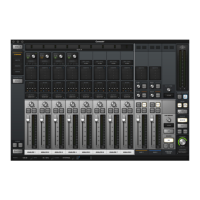Apollo Thunderbolt Software Manual Apollo Twin MkII Talkback 186
Apollo Twin MkII Talkback
Talkback Overview
Apollo Twin MkII includes a built-in talkback microphone, a dedicated talkback button,
and integrated talkback software functions in Console. This chapter explains the
configuration and operation of all talkback features and functionality for Apollo Twin
MkII.
Note: Talkback features are available only when Apollo Twin MkII is connected via
Thunderbolt.
Talkback Functions
Talkback is typically used by an operator in a studio’s control room to verbally
communicate with a performer in the studio’s recording/live room. The talkback mic can
also be routed into the DAW for recording.
Communication – The talkback mic can be routed to any cue mix bus and/or the main
monitor cue mix (and optionally to the main monitor outputs), or any combination of mix
buses simultaneously. Talkback send levels are independently adjustable for each mix
bus.
Recording – The talkback mic can be selected as a source for audio inputs in the DAW,
providing a convenient way to record slate cues or complete acoustic performances in
audio tracks without a separate external mic.
Configuration
All talkback functions, such as mix bus destinations and send levels, are configured in a
dedicated Talkback Input Strip and Talkback Sends Popover in the Control Room module
within Console.
Talkback is fully integrated into Apollo mixed multi-unit workflows for flexible signal
routing when additional Apollos are connected via Thunderbolt.
The cue buses in the Talkback Sends popover are the same as the cue buses in the
standard Sends Popover available on all Console inputs. See the Cues Overview for
related information.
Operation
Talkback can be activated using the dedicated hardware TALK button on Apollo Twin
MkII’s top panel or the TALK button within Console’s talkback input strip. The TALK
button can latch for continuous talkback, or press-hold-release for momentary talkback.
Note: See Using Talkback for quick operating instructions.

